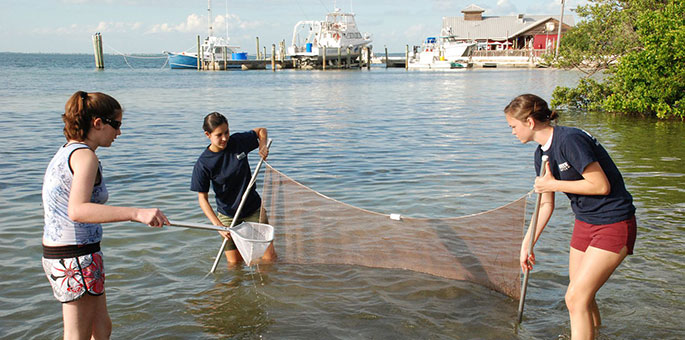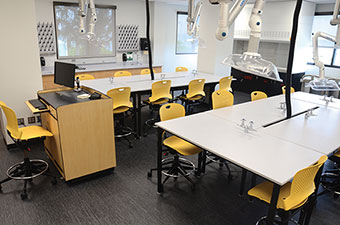Features
Learning from the Bay
| USF Sarasota-Manatee

Mote Marine Laboratory interns work with a seine net at Mote’s main campus.
Photo courtesy of Mote Marine Laboratory
All around the Mote Marine Laboratory in Sarasota, scientists are researching new ways to fight cancer, possible new antibiotics from the sea, and discoveries that will promote conservation and sustainable use of marine resources. Meanwhile, just outside the USFSM laboratory windows on the Mote campus, dolphins and recreational boaters float through the azure waters of Sarasota Bay.
It’s not your typical classroom setting.
The USFSM labs built at Mote over the past five months leverage the strengths of both institutions in a marriage of academics, research and business. Mote researchers hold courtesy faculty appointments at USFSM, sharing their real-world experience with students, who will one day lead the next wave of Florida’s scientists, engineers, technicians and business visionaries.

At a Glance
- 5,000 square feet: 2 science labs, storage and prep lab areas, a student commons and faculty offices
- $1.5 million for construction and equipment
- $2.2 million raised from foundations, corporations and individual donors
- Designed in Sept. 2012, construction begun in March 2013, completed in August 2013
- Architecture and interior design services by Fawley Bryant
- Construction by Willis A. Smith
The newly constructed labs will be the site for all USFSM biology and chemistry classes, as well as an inquiry-based bachelor’s degree program in biology, set to launch in fall 2014. Curriculum for the new degree program is unique to the region, and incorporates the core concepts and competencies for biology majors as outlined by the National Science Foundation and the American Association for the Advancement of Science.
“We are training the next generation of STEM thinkers to use science and technology-based discoveries as an economic engine for the development of our region,” says USFSM Regional Chancellor Arthur Guilford. “Our graduates will be fully prepared with opportunities to pursue careers in medicine, healthcare, environmental science and other fields utilizing their solid foundation in science.”
Erin Martin, coordinator of the new general education curriculum as well as developer of the biology program at USFSM, says students will be immersed in the process of science in the new Mote setting — learning to practice science as science is done.
“Students in our labs will practice science right alongside people who do research every day,” she says. “At Mote, biology and chemistry are put to use for restoring coral reefs, finding eco-friendly ways to farm seafood and for other projects that benefit the oceans and society. Here they’ll get the total immersion that students seek at large universities, where it’s usually found behind the closed doors of labs.”
Jane A. Rose, dean of the USFSM College of Arts & Sciences and architect of the new program, says USFSM’s partnership with Mote has been more than five years in the making and fast-tracked for the past two years, as $2.2 million from foundations, corporations and individual donors have enabled the dream to be realized.
Michael Crosby, president and CEO of Mote, says the partnership is focused on the future.
“There is so much potential here for innovation,” says Crosby. “Exposing students to all these fields and the expertise of our researchers will prepare them for many different paths they can follow and excel in when they graduate. They’ll come out ready to really take on the world, and it is exciting to be a part of that.”